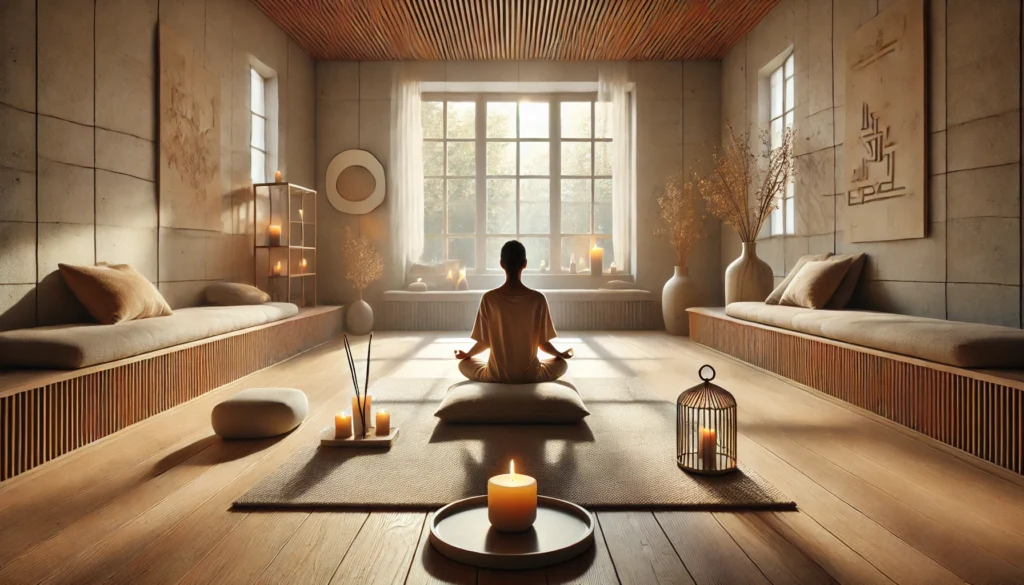In an era where anxiety disorders are becoming increasingly prevalent, the need for effective coping mechanisms has never been more critical. Guided meditation stands out as a potent tool for alleviating anxiety, offering a path to tranquility and mental clarity. This article will delve into a comprehensive meditation script designed to address physical anxiety symptoms, while also exploring the scientific underpinnings of its efficacy.
You may also like: Natural Supplements for Effective Anxiety Relief

Understanding Anxiety and the Role of Meditation
Before diving into the script, it’s important to understand the nature of anxiety and how mindfulness meditation can be beneficial. Anxiety is a natural response to stress, often manifesting as feelings of fear or apprehension about the future. While anxiety can be a normal part of life, chronic anxiety can lead to debilitating symptoms that interfere with daily activities.
The Nature of Anxiety
Anxiety can manifest in various forms, from generalized anxiety disorder to panic attacks, each with its own set of challenges. The root of anxiety often lies in the body’s fight-or-flight response, a survival mechanism that can become overactive. Understanding this response is crucial in managing anxiety effectively.
Chronic anxiety not only affects mental health but can also lead to physical symptoms such as increased heart rate, muscle tension, and fatigue. These symptoms create a feedback loop, where physical discomfort exacerbates mental distress, making it vital to address both simultaneously.
Mindfulness Meditation: An Ancient Practice
Mindfulness meditation, a practice rooted in ancient traditions, has gained significant attention in recent years for its ability to reduce stress and anxiety. Originating from Buddhist practices, mindfulness has been adapted into a secular form that focuses on awareness and acceptance.
By focusing on the present moment and observing thoughts and feelings without judgment, individuals can create a mental space that promotes calmness and relaxation. This practice empowers individuals to step back from their thoughts and emotions, reducing the power they hold over their mental state.
Modern Adaptations and Accessibility
In today’s fast-paced world, mindfulness meditation has been adapted to fit modern lifestyles, making it more accessible to a wider audience. Mobile apps, online courses, and community classes offer guided sessions, allowing individuals to practice meditation anytime and anywhere.
These adaptations have helped demystify meditation, showing that it is not about emptying the mind but rather about acknowledging and accepting one’s thoughts. This shift in understanding has encouraged more people to incorporate mindfulness into their daily routines.
The Science Behind Meditation and Anxiety
Scientific studies have shown that mindfulness meditation can lead to structural and functional changes in the brain, particularly in areas associated with emotional regulation. The practice has been linked to reduced activity in the amygdala, the brain’s center for stress and fear responses, and increased connectivity in regions responsible for attention and concentration.
Neuroplasticity and Emotional Regulation
One of the most fascinating aspects of meditation is its impact on neuroplasticity, the brain’s ability to reorganize itself by forming new neural connections. Regular meditation practice strengthens the prefrontal cortex, enhancing emotional regulation and executive function.
This strengthening leads to improved decision-making and a greater ability to manage stress, providing a buffer against anxiety. As the brain becomes more adept at regulating emotions, individuals experience a reduction in the intensity and frequency of anxiety symptoms.
Hormonal and Neurotransmitter Changes
Furthermore, meditation has been found to lower cortisol levels, a hormone released in response to stress, while enhancing the production of serotonin and dopamine, neurotransmitters that contribute to feelings of well-being and happiness. Lower cortisol levels result in reduced physical symptoms of anxiety, such as tension and fatigue.
The increase in serotonin and dopamine not only elevates mood but also supports motivation and concentration, creating a positive feedback loop that reinforces the benefits of meditation. This biochemical balance plays a crucial role in maintaining mental health and resilience.
Long-term Benefits and Sustainability
The long-term benefits of meditation extend beyond immediate anxiety relief, contributing to overall mental and physical well-being. Regular meditation practice has been linked to improved sleep quality, enhanced immune function, and greater overall life satisfaction.
These benefits highlight the sustainability of meditation as a coping mechanism, offering a holistic approach to health that complements other therapeutic practices. By committing to meditation, individuals can foster a lasting sense of peace and resilience.
Preparing for Meditation
Before beginning the meditation, find a quiet and comfortable space where you won’t be disturbed. Sit in a chair with your feet flat on the floor, or cross-legged on a cushion. Ensure your back is straight, but not tense, allowing your hands to rest comfortably on your lap.
Creating a Calming Environment
The environment in which you meditate can significantly influence the quality of your practice. Choose a space that feels calming and free from distractions, where you can fully immerse yourself in the experience. Consider dimming the lights or lighting a candle to create a serene atmosphere.
Some individuals find that playing soft, instrumental music or nature sounds helps enhance their meditation experience. These auditory elements can act as an anchor, drawing your attention away from intrusive thoughts and into the present moment.
Establishing a Routine
Consistency is key when it comes to reaping the benefits of meditation. Aim to meditate at the same time each day, whether it’s in the morning to set a peaceful tone for the day or in the evening to unwind before bed. Establishing a routine makes it easier to commit to regular practice.
Even short sessions of 5-10 minutes can be effective, especially for beginners. As you become more comfortable with the practice, gradually increase the duration to deepen your experience and enhance its benefits.
Setting the Intention
Close your eyes and take a deep breath. As you exhale, set the intention to alleviate anxiety and cultivate a state of peace and relaxation. Remember that meditation is a practice, and it’s okay for your mind to wander. Simply bring your attention back to your breath whenever you notice it drifting.
Setting an intention anchors your practice, providing a sense of purpose and direction. This intentional focus helps ground you, making it easier to return to the present moment when your mind begins to wander.

The Guided Meditation Script
Beginning the Practice
- Focus on the Breath: Begin by focusing on your breath. Notice the sensation of air entering through your nose, filling your lungs, and then gently leaving your body. With each exhale, imagine releasing tension and anxiety.
Focusing on the breath serves as the foundation of meditation, anchoring you in the present moment. By concentrating on the natural rhythm of your breath, you create a buffer between your thoughts and your emotional responses. This separation allows you to observe your thoughts without becoming overwhelmed by them.
- Body Scan: Shift your attention to your body. Starting from the top of your head, slowly scan down to your toes, noticing any areas of tension or discomfort. As you identify these areas, take a deep breath in, and as you exhale, imagine the tension melting away.
A body scan is a powerful technique for increasing awareness of physical sensations and releasing stored tension. By systematically focusing on each part of the body, you can identify areas of discomfort and consciously relax them, fostering a sense of physical and mental ease.
Visualizing Calmness
- Create a Safe Space: Picture a place where you feel completely at ease. This could be a real location or an imagined sanctuary. Visualize the details vividly—colors, sounds, and scents. Allow yourself to linger in this safe space, feeling the peace it brings.
Visualizing a safe space taps into the mind’s creative abilities, allowing you to construct a mental refuge from anxiety. This visualization can evoke a sense of comfort and security, helping you detach from stressors and immerse yourself in tranquility.
- Affirmations for Peace: Silently repeat affirmations that resonate with you, such as “I am calm and at peace,” or “I release my worries and embrace tranquility.” Feel the positive energy of these affirmations envelop you.
Affirmations are a form of self-talk that can shift your mindset and reinforce positive beliefs. By repeating affirmations, you replace negative thought patterns with empowering ones, fostering a sense of inner peace and confidence.
Engaging the Senses
- Listen to the Silence: Focus on the silence around you, even if faint sounds are present. Let the quietness anchor you in the present moment, offering a respite from anxious thoughts.
Silence is a powerful anchor that can ground you in the present moment. By embracing the quiet, you create space for introspection and calm, allowing your mind to settle and your body to relax.
- Savor the Present: Engage your senses by noticing any scents in the air, the sensation of your clothing against your skin, or the taste in your mouth. Grounding yourself in the present can shift your focus away from anxiety.
Engaging the senses is a grounding technique that draws attention away from anxious thoughts and into the immediate experience. By fully immersing yourself in the present, you create a buffer against the mental chatter that fuels anxiety.
Transitioning Out of Meditation
As the meditation draws to a close, gradually bring your awareness back to the room. Wiggle your fingers and toes, and when you’re ready, slowly open your eyes. Take a moment to notice how you feel compared to when you started.
Reflecting on the Experience
After meditation, take a few moments to reflect on your experience and any changes in your mental or physical state. This reflection reinforces the benefits of meditation, encouraging you to continue the practice.
Recognize any shifts in your mood or outlook, no matter how subtle. Over time, these small changes accumulate, contributing to overall well-being and resilience.
Gentle Movement and Reconnection
Incorporate gentle movements to ease your transition from meditation back to daily activities. Stretching or light yoga can help release any residual tension and reconnect your mind with your body.
This physical reconnection enhances the calming effects of meditation, ensuring that you carry its benefits into the rest of your day.
Integrating Mindfulness into Daily Life
Meditation is a powerful tool, but its effects can be amplified when mindfulness is integrated into daily activities. Practice mindful eating by savoring each bite, or engage in mindful walking by noticing each step and the environment around you. By weaving mindfulness into your routine, you can cultivate a sustained sense of calmness and resilience.
Mindful Eating
Mindful eating involves paying full attention to the experience of eating and drinking, both inside and outside the body. Notice the colors, smells, textures, and flavors of your food. Chew slowly and savor each bite, recognizing the nourishment it provides.
This practice not only enhances your appreciation for food but also promotes better digestion and satisfaction, reducing mindless snacking and overeating.
Mindful Walking
Mindful walking turns the simple act of walking into a meditative practice. Focus on the sensations of your feet touching the ground, the rhythm of your breath, and the sights and sounds around you.
By bringing awareness to your movements, you transform walking into an opportunity for relaxation and reflection, a moving meditation that can be practiced anywhere.
Mindful Communication
Practice mindfulness in your interactions by listening actively and speaking with intention. Before responding, take a moment to consider your words and their potential impact.
Mindful communication fosters deeper connections with others, reduces misunderstandings, and enhances empathy and understanding in your relationships.

Conclusion: The Future of Meditation and Mental Health
As the understanding of meditation’s impact on mental health continues to evolve, its integration into mainstream wellness practices is becoming increasingly common. From mobile apps offering guided sessions to workplace mindfulness programs, the accessibility of meditation has expanded, offering more individuals the opportunity to harness its benefits.
The Growing Popularity of Meditation
Meditation’s popularity continues to rise as more people recognize its potential for enhancing mental health and well-being. Institutions ranging from schools to corporations are incorporating mindfulness programs to support mental health initiatives.
This widespread adoption reflects a shift towards holistic approaches to health, recognizing the interconnectedness of mind, body, and spirit in achieving overall wellness.
Meditation as a Complementary Therapy
Meditation is increasingly used as a complementary therapy alongside traditional mental health treatments. Its ability to reduce stress, improve emotional regulation, and enhance overall quality of life makes it a valuable addition to therapeutic practices.
As research continues to uncover the benefits of meditation, its role in mental health care is expected to grow, offering individuals more tools to manage anxiety and other challenges.
Empowering Individuals with Mindfulness
In conclusion, this guided meditation script serves as a practical tool for those seeking to alleviate anxiety and embrace a more peaceful existence. By committing to regular practice and integrating mindfulness into everyday life, individuals can foster a profound transformation in their mental and emotional well-being.
The future of meditation and mental health is promising, with increasing opportunities for individuals to explore and integrate mindfulness practices into their lives. As more people experience the transformative power of meditation, the potential for a more mindful, compassionate world becomes increasingly attainable.
Further Reading:
A Guided Meditation for Anxiety: Calm Place
9 Guided Meditation Scripts for Anxiety
Anxiety Relief Scripts for Relaxation
Important Note: The information contained in this article is for general informational purposes only, and should not be construed as health or medical advice, nor is it intended to diagnose, prevent, treat, or cure any disease or health condition. Before embarking on any diet, fitness regimen, or program of nutritional supplementation, it is advisable to consult your healthcare professional in order to determine its safety and probable efficacy in terms of your individual state of health.
Regarding Nutritional Supplements Or Other Non-Prescription Health Products: If any nutritional supplements or other non-prescription health products are mentioned in the foregoing article, any claims or statements made about them have not been evaluated by the U.S. Food and Drug Administration, and such nutritional supplements or other health products are not intended to diagnose, treat, cure, or prevent any disease.


